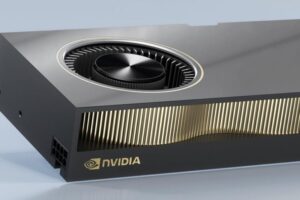
Extreme Performance
Built on the NVIDIA Ampere architecture, the NVIDIA RTX A6000 gives designers, engineers, scientists, and artists everything they need to meet the most graphics- and compute-intensive workflows. The RTX A6000 features the latest generation of RT Cores, Tensor Cores, and CUDA® cores, resulting in unrivaled rendering, AI, graphics, and compute performance.
NVIDIA RTX is the visual computing solution of choice for demanding enterprise deployments, with a broad range of professional applications certified, tested by leading independent software vendors (ISVs) and workstation manufacturers, and backed by a global team of support specialists.
Ampere Architecture
NVIDIA® RTX technology has forever changed professional visual computing. The NVIDIA Ampere architecture leverages the power of RTX to significantly improve rendering, graphics, AI, and compute workload performance. The NVIDIA Ampere architecture, which has been meticulously engineered and features cutting-edge innovations, takes RTX to new heights for professional workloads.
Third Generation Tensor Cores
The new Tensor Float 32 (TF32) precision increases training throughput by up to 5X over the previous generation, allowing AI and data science models to be trained faster without requiring any code changes. Hardware support for structural sparsity doubles inferencing throughput. Tensor Cores also bring AI to graphics with features such as DLSS, AI denoising, and enhanced editing for a limited number of applications.
Second Generation RT Cores
Second-generation RT Cores deliver massive speedups for workloads like photorealistic rendering of movie content and virtual prototyping of product designs, with up to 2X the throughput of the previous generation and the ability to run ray tracing with either shading or denoising capabilities concurrently.
This technology also improves the speed with which ray-traced motion blur is rendered, resulting in faster results with greater visual accuracy.
Ampere Architecture based Cuda Cores
The CUDA cores in the NVIDIA Ampere architecture provide twice the processing speed for single-precision floating point (FP32) operations and are up to 2X more power efficient than Turing GPUs. For graphics workflows like 3D model development and compute workflows like desktop simulation for computer-aided engineering, this results in significant performance gains (CAE).
PCI Express Gen 4
PCI Express Gen 4.0 (PCIe Gen 4.0) is supported by NVIDIA Ampere architecture-based GPUs, which provide 2X the bandwidth of PCIe Gen 3.0. For data-intensive tasks like AI and data science, this improves data transfer speeds from CPU memory. GPU direct memory access (DMA) transfers are also accelerated by faster PCIe performance, allowing for faster video data transfers from GPUDirect® for video-enabled devices and speedier input/output (I/O) with GPUDirect Storage.
Third Gen NVLink
Users can connect two GPUs using third-generation NVIDIA NVLink® technology to share GPU performance and memory. Professionals can tackle the largest rendering, AI, virtual reality, and visual computing workloads with up to 112 gigabytes per second (GB/s) of bidirectional bandwidth and combined graphics memory of up to 96 GB. The new NVLink connector also has a lower Z height, allowing NVLink to be used in a wider range of chassis.
NGC Support
Engineers, researchers, and data scientists can use NGC support to access NVIDIA-tuned, tested, certified, and maintained containers for the most popular deep learning frameworks, as well as third-party managed HPC containers, NVIDIA HPC visualization containers, and partner applications.
Rich Visual Workspace
With the DisplayPort 1.4a standard, you can get stunning imagery with movie-quality anti-aliasing techniques, high-dynamic-range (HDR) color support, higher refresh rates, and up to 8K screen resolution at 60 Hz from a single cable.
Value for IT Admins
Higher-quality products are powered by energy-efficient hardware and components that have been carefully chosen for their operational performance, durability, and longevity.
Extensive product testing with leading OEMs and system integrators simulates the most demanding real-world conditions, ensuring maximum uptime.
Integrate the NVIDIA Enterprise Management Toolkit (NVWMI) into your IT asset management framework to remotely monitor and manage NVIDIA professional products in your organization.
NVWMI’s powerful driver installer can scale NVIDIA RTX Enterprise driver deployment to hundreds of workstations.
GPU memory 48 GB GDDR6
Memory interface 384-bit
Memory bandwidth 768 GB/s
Error-correcting code (ECC) Yes
NVIDIA Ampere architecture based CUDA Cores 10,752
NVIDIA third-generation Tensor Cores 336
NVIDIA second-generation RT Cores 84
Single-precision performance 38.7 TFLOPS7
RT Core performance 75.6 TFLOPS7
Tensor performance 309.7 TFLOPS8
NVIDIA NVLink Connects two NVIDIA RTX A6000 GPUs
NVIDIA NVLink bandwidth 112.5 GB/s (bidirectional)
System interface PCI Express 4.0 x16
Power consumption Total board power 300 W
Thermal solution Active
Form factor 4.4” H x 10.5” L, dual-slot, full-height
Display connectors 4x DisplayPort 1.4a9
Max simultaneous displays 4x 4096 x 2160 @ 120 Hz, 4x 5120 x 2880 @ 60 Hz, 2x 7680 x 4320@ 60 Hz
Power connector 1x 8-pin CPU
Encode/decode engines 1x encode, 2x decode (+AV1 decode)
VR ready Yes
vGPU software support NVIDIA vPC/vApps, NVIDIA RTX Virtual Workstation, NVIDIA Virtual Compute Server
vGPU profiles supported 1 GB, 2 GB, 3 GB, 4 GB, 6 GB, 8 GB,
12 GB, 16 GB, 24 GB, 48 GB
Graphics APIs DirectX 12.0710, Shader Model 5.1710, OpenGL 4.6811, Vulkan 1.1811
Compute APIs CUDA, DirectCompute, OpenCL
vGPU Software Support NVIDIA Virtual PC (vPC) / NVIDIA Virtual Applications (vApps) / NVIDIA RTX Virtual Workstation (vWS) / NVIDIA Virtual Compute Server (vCS) / vGPU Profiles from 1 GB to 48 GB
GPU SERVERS
Powered by NVIDIA RTX A6000 for powerful visual computing and data science applications.